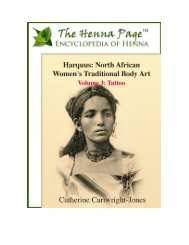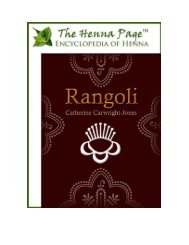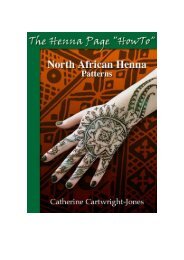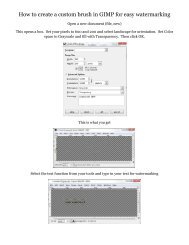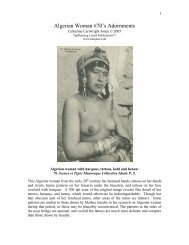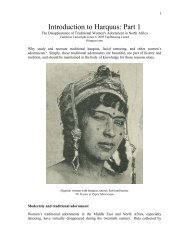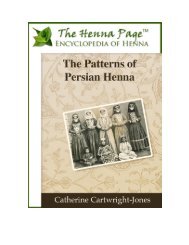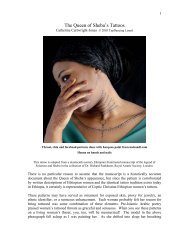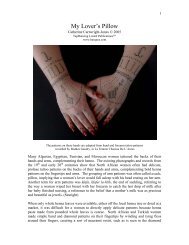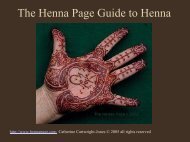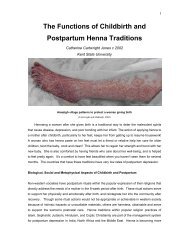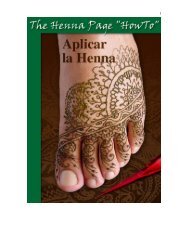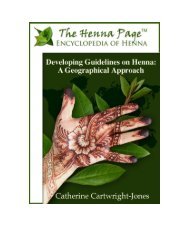Menstruation and Henna: Pollution and Purification - The Henna Page
Menstruation and Henna: Pollution and Purification - The Henna Page
Menstruation and Henna: Pollution and Purification - The Henna Page
Create successful ePaper yourself
Turn your PDF publications into a flip-book with our unique Google optimized e-Paper software.
<strong>The</strong> vagina is the entrance to a woman’s womb, open during her menstrual cycle. Menstrual<br />
blood flow, was believed in Sudan as other Muslim countries, to increase a woman’s vulnerability<br />
to spirit attack <strong>and</strong> possession, causing disease, infertility, <strong>and</strong> disaster (Kennedy, 1978: 159). A<br />
menstruating Hofriyati woman was at risk from jinn <strong>and</strong> zayran, spirits, which could enter her<br />
body through her vagina, via the blood. If they did so <strong>and</strong> possessed her womb, she would be<br />
sterile. Graveyards, teeming with jinn, were avoided by menstruating women, as she was so<br />
vulnerable to their attack. <strong>The</strong>se jinn could accompany people returning from a funeral or<br />
butchery, <strong>and</strong> if not ritually cleansed of these spirits, could inadvertently transmit them to the<br />
menstruating woman (Boddy 1989: 100 – 4).<br />
If the woman fell ill or infertile, she might have been diagnosed as spirit possessed, <strong>and</strong> could<br />
choose to be exorcised through a Zar ritual, an ethnomedical spirit trance ceremony. She would<br />
have elaborate purification <strong>and</strong> henna done in preparation for a Zar, as a ritual state of purity was<br />
necessary to attract benovelent spirits. Guests at the Zar also prepared themselves by bathing,<br />
dressing beautifully, <strong>and</strong> hennaing to negotiate an appropriate relationship with a zayran, a spirit,<br />
rather than an intrusive or destructive relationship with a malevolent spirit. Women who were<br />
menstruating knotted their braids so spirits would know they were unavailable for entry.<br />
Moroccan women had similar trance <strong>and</strong> dance therapeutic events, as well as halfla diel henna,<br />
henna parties. A woman would hold a henna party to quell malevolent jinn, or encourage<br />
protective ones. Women often held these parties, inviting all their adult female friends, in the<br />
month prior to Ramadan, Sha’ban, to secure additional protection during fasting, when they<br />
would be weakened, <strong>and</strong> thus more vulnerable to evil spirits. If a family did not have a skillful<br />
artist, they hired a mu’allima, a professional henna artist, to come <strong>and</strong> apply henna. <strong>The</strong>se artists<br />
were often of low social status, former dancers <strong>and</strong> entertainers, who had learned traditional<br />
patterns from their mothers. <strong>The</strong> mu’allima hennaed protective patterns to assuage, deter <strong>and</strong><br />
“<strong>Menstruation</strong> <strong>and</strong> <strong>Henna</strong>, <strong>Pollution</strong> <strong>and</strong> <strong>Purification</strong>”, was written by Catherine Cartwright-Jones as partial completion<br />
of the requirements for a Master’s degree in Liberal Studies focusing on henna, under the supervision of Dr. A Smith<br />
<strong>and</strong> Dr. N Ammar, Kent State University, Kent Ohio, USA<br />
36



